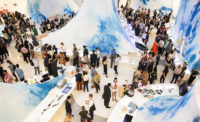The architecture firm PBK had just received a permit to begin construction on a new elementary school in the Austin, Texas, suburb of Round Rock when COVID-19 hit the United States. “We quickly huddled up and put solutions together to adapt the design in light of the virus,” says Darrell Pearson, a firm partner.
For PBK, with 15 offices and a large portfolio of K-12 projects, Round Rock’s Elementary #35 is a test case of sorts—the first school PBK will complete in the time of the novel coronavirus. If its adaptations are successful, it may be a harbinger of new design trends that will be rapidly implemented elsewhere in Texas. For Elementary #35, PBK asked how they could “crash together” the open, collaborative environment they had designed with the need for the socially-distanced and protected spaces that are necessary to help prevent the spread of the virus.

It’s a question that school districts and architects are scrambling to answer as the start of new academic year rapidly approaches. Thousands of school buildings, new and existing, must now accommodate an invisible threat. Firms including Gensler, EUA, SITU, and Mitchell Giurgola, among others, have released white papers and plans for how to safeguard students and staff against the virus, with ideas that include changes to HVAC systems, the deployment of signage and touchless technologies, and one-way circulation. The London-based firm Curl La Tourelle Head Architecture has designed a socially distanced tent for a primary school in the city’s East End, inspired by Denmark’s outdoor classrooms, with plans to erect more of them.

At PBK, Pearson’s team was able to pull together a series of adaptations to architectural features and mechanical systems at the new elementary school that don’t significantly alter its programming or appearance. They include an upgraded air filtration system that mimics those found in healthcare environments; UV lighting, which sanitizes air and surfaces; isolation rooms in the health clinic; taller partitions between bathroom stalls; and signage that re-choreographs the flow of students and staff through the building to help maintain the CDC-recommended six feet of separation between individuals. Many of these ideas are outlined in general in a white paper that PBK released for other clients. “It’s a living document,” says Richard Chi, PBK’s co-CEO and director of design. “We wanted to come up with some feasible solutions and continue to have a dialogue to help along the way.”
SITU, a Brooklyn-based architecture, fabrication, and research firm has been part of a consortium, including WXY, Gensler, PSF Projects Architecture, and PBDW, that was asked to create a toolkit of potential changes to the Brooklyn Laboratory Charter Schools (LAB), a middle and high school in downtown Brooklyn. Each firm was tasked with tackling a particular area of the school; SITU studied the arrival and entry process for students and staff, a particular challenge at LAB, which is located on multiple floors of a commercial office building on a busy corner. In order to accommodate social distancing and daily temperature checks, the school will have to extend deeper into the public space.

Ultimately, SITU landed on the idea of using a pre-engineered sidewalk shed, customized with planters, signage, and perhaps even student-created artwork, to introduce a new “front porch” to the school and guide students to two different entries. (Still, this would only be possible if LAB’s 1,000 students were split into two groups, alternating virtual learning with time spent in the school building. The groups would be further divided to stagger entry.) A third egress could be created by turning a window on an upper floor into a door and adding an exterior metal stair. Temperature checks could take place in semi-enclosed stations in the shed with perforated walls for airflow and privacy. SITU is now working with WXY to advance some of these ideas further. “The goal is to get something built and open by September,” says SITU Partner Basar Girit. “This is a tool for everyone, so we’re happy to be trying to execute this, and not just speculate.”
And while a survey is circulating now from New York City’s Department of Education (DOE), asking parents to weigh in on preferences for in-person and remote learning and stressing that the 2020/2021 school year will likely include a mix of both, architects at Mitchell Giurgola responded to a request by the Urban Design Forum and the School Construction Authority to create a pamphlet that looks at how the City’s 1,700 public schools might be able to open in the fall. “What we tried to posit was a very simple program that suggested a partnership between the Department of Health, the DOE, and the design community,” says Mitchell Giurgola partner Paul Broches. His firm has a long history of designing and adapting the city’s public schools. “As an urban designer, I think of the schoolhouse as the primary anchor of the community.” Like other firms, Mitchell Giurgola studied airflow, circulation, signage, and switching cohorts of students between in-person and virtual learning to lessen the numbers of kids in classrooms at one time.
The firm’s white paper begins with a powerful and provocative statement, and one that all parents and schools must be wrestling with: “Every day that primary and secondary age children are not in school they face serious risk to their physical health. Whether it be COVID-19, flu season next year, undernourishment or trauma, the place to address them is at the schoolhouse door.”








Post a comment to this article
Report Abusive Comment